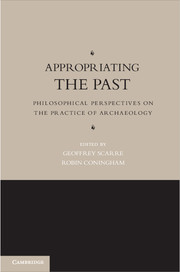Book contents
- Frontmatter
- Contents
- Contributors
- Editors
- Chapter 1 Introduction
- Part One Claiming the Past
- Part Two Problems of Meaning and Method
- Chapter 8 What Is a Crisis of Intelligibility?
- Chapter 9 Contesting Religious Claims over Archaeological Sites
- Chapter 10 Multivocality and “Wikiality”
- Chapter 11 “Do not do unto others…”
- Chapter 12 Should Ruins Be Preserved?
- Part Three Problems of Ownership and Control
- References
- Index
Chapter 12 - Should Ruins Be Preserved?
Published online by Cambridge University Press: 05 December 2012
- Frontmatter
- Contents
- Contributors
- Editors
- Chapter 1 Introduction
- Part One Claiming the Past
- Part Two Problems of Meaning and Method
- Chapter 8 What Is a Crisis of Intelligibility?
- Chapter 9 Contesting Religious Claims over Archaeological Sites
- Chapter 10 Multivocality and “Wikiality”
- Chapter 11 “Do not do unto others…”
- Chapter 12 Should Ruins Be Preserved?
- Part Three Problems of Ownership and Control
- References
- Index
Summary
Early in May 2009, I was flying back to the United Kingdom from Malta. Shortly after takeoff, I looked downward out of the aeroplane window and saw on the ground an object that has been described as resembling a giant hang glider or crashed UFO. It was the enormous Teflon-covered tent that had just been erected to protect one of the Maltese megalithic temples. Since the unearthing of these temples in the nineteenth century, their soft globigerina stone has, apparently, been deteriorating. The tent quickly generated a lively e-mail correspondence in the newspapers. Most of the letters either denounced the ugliness of the cover or praised its benefits for tourism. Some correspondents, however, addressed the question of the appropriateness of erecting a cover at all, irrespective of its charms or utility. ‘Let Mother Nature do its bidding’, wrote one correspondent, ‘If they [the temples] have to fall, so let it be’. In response to such e-mails, another correspondent, while conceding that ‘ruins abandoned to the natural elements have their fascination’, argued that important archaeological remains could no more be allowed to ‘deteriorate completely’ than a sick old person could be abandoned to die (Times of Malta On-line, 11 May 2009).
COMPETING PRIORITIES
The tension between preservation and other priorities that this correspondence illustrates is a familiar one. A well-known instance in Britain was the debate that surrounded the fate of Seahenge, the ancient timber circle that was exposed on the Norfolk coast when the sea receded. In 1999, English Heritage removed the wooden pillars from the site and had them restored and placed, eventually, in a museum in King's Lynn. Many people protested against this action – so vociferously, in fact, that another exposed timber circle, Holme II, was left in situ and open to the elements that will eventually destroy it.
- Type
- Chapter
- Information
- Appropriating the PastPhilosophical Perspectives on the Practice of Archaeology, pp. 222 - 236Publisher: Cambridge University PressPrint publication year: 2012
- 3
- Cited by



